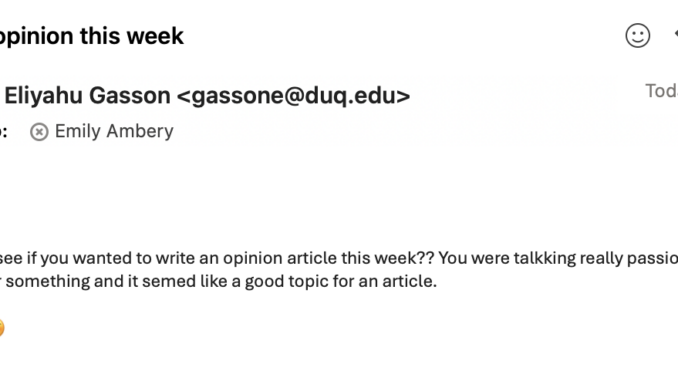
Emily Ambery | Layout Editor
Since the turn of the century, email has become the primary mode of communication in the modern American office.
While this technology has revolutionized communication, it has also become a burden.
The average full-time worker in America receives 120 emails per day, according to a McKinsey report. This flooded inbox takes 28% of the work day to address, on top of the role-specific task completed 39% of the day.
While email etiquette might sound antiquated, only 25% of those 120 emails get a response. So upping your email etiquette game will help you get the response you deserve and be part of that 25%.
As we move from students to professionals, implementing good email etiquette now can help us navigate corporate communication.
Etiquette includes knowing when to send an email, how to address it and response expectations. Emails do not have to be a formal decree, but they should be relatively polite and professional.
The advent of texting and smartphones has put people under the illusion that everyone should be available to respond to email requests and questions 24/7. Not only is this wildly unrealistic, it’s also annoying for both parties.
Getting an email at 11 p.m. can be disruptive to work/life balance and reading it the night before you can actually complete the task risks it getting forgotten the next day.
While it can vary between jobs, if the subject is not life-threatening or time-sensitive, typically the time frame in which an email should be sent is around 9 to 5. Timing your emails should respect the recipient’s time as they are not on the clock 24/7.
Most email platforms have even built this into their software with a “schedule send” feature, allowing someone to draft the email anytime they want. Conveniently, rather than sending it then, it “sends” it at a time of your choosing, which should be within 9 a.m. to 5 p.m., the standard workday.
People may request emails at specific times during the day which may be outside of the 9-5, and if that is the case, then send it at their requested time.
In addition to sending it at the right time, emails should be addressed to the right people. Just because many people may be relevant to the subject of the email you are sending does not mean you need to CC everyone.
Inboxes are already full. Making sure that the relevant people are copied to the email makes your messages more efficient and concise.
According to Harvard Business Review, “professionals delay replying 37% of the time,” showing that emails take time. Someone might be out of the office, on a tight deadline for another project or just needs time to find information to answer an email.
Expecting a response within 12 hours, while that would be ideal and sometimes happens, is unrealistic. According to email analytics software TimetoReply, waiting 3-5 business days before sending a follow-up is appropriate.
Before even sending or schedule sending an email, it’s important to consider if the question could be answered otherwise. For example, at school, if the email could be answered by looking at the syllabus, it’s a waste of everyone’s time not to check the information you have first.
Once it’s determined that an email is worth the hassle of sending out, Business News Daily suggests that opening an email with “Hi” or “Hey” is only appropriate for an already established connection with the receiver.
An email to someone you only vaguely know should be addressed with “good morning” or “good afternoon.” An introduction should follow the address, so the recipient knows why you are relevant.
Because emails are so time-consuming for the average employee, Jodi R.R. Smith, owner of the etiquette consulting business Mannersmith, told Business News Daily that recipients only read the first line or two in their decision to keep or delete an email.
Not only should emails get to the point quickly, but they should remain concise. They are not texts, but they are also not essays. They should not be filled with jargon and unfortunately should not have emoji. ☹️
While email may seem like a silly thing to require an “etiquette,” it is most likely how you will make a first impression on someone, and making sure it is a good one is crucial to job offers, industry connections and receiving an extension on your paper.
